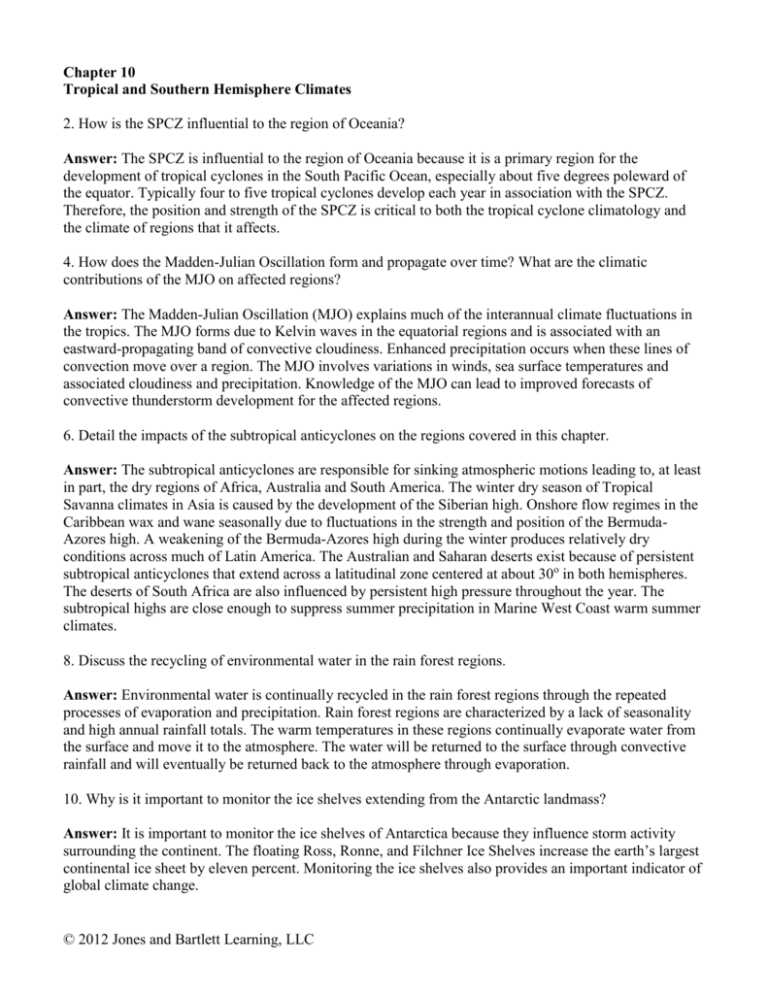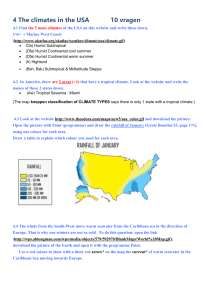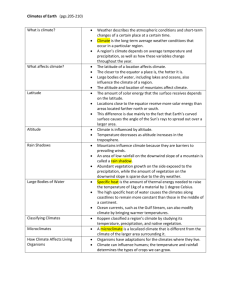Chapter 10 – Tropical and Southern Hemisphere Climates
advertisement

Chapter 10 Tropical and Southern Hemisphere Climates 2. How is the SPCZ influential to the region of Oceania? Answer: The SPCZ is influential to the region of Oceania because it is a primary region for the development of tropical cyclones in the South Pacific Ocean, especially about five degrees poleward of the equator. Typically four to five tropical cyclones develop each year in association with the SPCZ. Therefore, the position and strength of the SPCZ is critical to both the tropical cyclone climatology and the climate of regions that it affects. 4. How does the Madden-Julian Oscillation form and propagate over time? What are the climatic contributions of the MJO on affected regions? Answer: The Madden-Julian Oscillation (MJO) explains much of the interannual climate fluctuations in the tropics. The MJO forms due to Kelvin waves in the equatorial regions and is associated with an eastward-propagating band of convective cloudiness. Enhanced precipitation occurs when these lines of convection move over a region. The MJO involves variations in winds, sea surface temperatures and associated cloudiness and precipitation. Knowledge of the MJO can lead to improved forecasts of convective thunderstorm development for the affected regions. 6. Detail the impacts of the subtropical anticyclones on the regions covered in this chapter. Answer: The subtropical anticyclones are responsible for sinking atmospheric motions leading to, at least in part, the dry regions of Africa, Australia and South America. The winter dry season of Tropical Savanna climates in Asia is caused by the development of the Siberian high. Onshore flow regimes in the Caribbean wax and wane seasonally due to fluctuations in the strength and position of the BermudaAzores high. A weakening of the Bermuda-Azores high during the winter produces relatively dry conditions across much of Latin America. The Australian and Saharan deserts exist because of persistent subtropical anticyclones that extend across a latitudinal zone centered at about 30o in both hemispheres. The deserts of South Africa are also influenced by persistent high pressure throughout the year. The subtropical highs are close enough to suppress summer precipitation in Marine West Coast warm summer climates. 8. Discuss the recycling of environmental water in the rain forest regions. Answer: Environmental water is continually recycled in the rain forest regions through the repeated processes of evaporation and precipitation. Rain forest regions are characterized by a lack of seasonality and high annual rainfall totals. The warm temperatures in these regions continually evaporate water from the surface and move it to the atmosphere. The water will be returned to the surface through convective rainfall and will eventually be returned back to the atmosphere through evaporation. 10. Why is it important to monitor the ice shelves extending from the Antarctic landmass? Answer: It is important to monitor the ice shelves of Antarctica because they influence storm activity surrounding the continent. The floating Ross, Ronne, and Filchner Ice Shelves increase the earth’s largest continental ice sheet by eleven percent. Monitoring the ice shelves also provides an important indicator of global climate change. © 2012 Jones and Bartlett Learning, LLC 12. Discuss Tropical Monsoon climates. Answer: The Tropical Monsoon climate is found mainly along coastal margins and in larger sections of South and Southeast Asia that receive persistent onshore winds for much of the year. This climate is caused by monsoonal wind shift associated with the development of the Siberian high during winter and the thermal low during summer. This climate type is noted by its distinctive rainfall pattern with extreme monthly rainfall totals during the summer months in association with the summer monsoon. Tropical Monsoon climates exhibit a short dry season during the winter months when these regions are dominated by offshore winds. Monthly average temperatures always exceed 18oC (64oF) with the warmest times of the year found during the late spring before the onset of the summer monsoon. 14. Why are deserts so extensive throughout the regions covered in this chapter? Answer: The dry regions covered in this chapter represent the most extensive climate type on earth. Desert regions are widespread in the Southern Hemisphere primarily because of a persistent band of high atmospheric pressure that exists across a latitudinal zone centered at 30oS. Many desert regions do not lack precipitation because of a lack of moisture, but due to the lack of a precipitation-generating mechanism. Precipitation in desert regions has to overcome the physical and atmospheric barriers that normally prevent the production of rainfall. 16. Discuss the causes of mesothermal climates in the associated regions. Answer: The mesothermal climates are sparse in the southern hemisphere due to a limited amount of land area in the appropriate latitudes. The eastern and southern coasts of Australia and all of New Zealand are designated as mesothermal climates. Portions of the extreme coastal zones of southern and northern Africa and southeastern and southwestern sections of South America also have mesothermal climates. Warm season precipitation in southern hemisphere mesothermal climates is largely due to convective activity. In southern hemisphere Humid Subtropical climates most precipitation is caused by frontal systems during the cool season. Hot summers and moderate winters characterize this climate’s temperature regime. The Mediterranean climate of coastal northwestern Africa has a wintertime peak of precipitation due to the passage of midlatitude frontal systems. Temperatures are very comfortable and pleasant throughout the year in Mediterranean climates. Marine West Coast climates also have a wintertime precipitation peak but the precipitation characteristics are the result of high pressure that suppresses large precipitation totals in the summer. Marine West Coast climate experience the coolest temperatures of the southern hemisphere mesothermal climates. 18. Why is stratospheric ozone so important to the high-latitude regions of the southern hemisphere? Answer: Stratospheric ozone is extremely important to the high-latitude regions of the southern hemisphere due to the ozone hole over Antarctica. Chlorofluorocarbons (CFCs) and other gases that react with oxygen become trapped over Antarctica during the winter. This has resulted in a net increase in the size of the ozone hole in addition to the ozone hole extending into the spring months. This result has been detrimental to the ecosystem due to the increases in UV radiation. Most earth and environmental scientists agree that the entire oceanic food chain will be adversely affected if the trend of increased UV radiation continues. © 2012 Jones and Bartlett Learning, LLC








